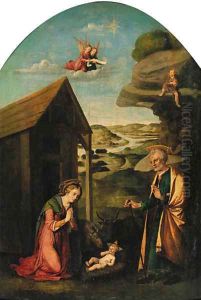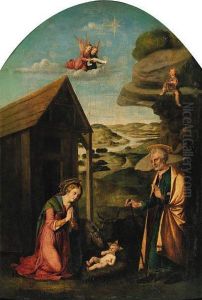Pellegrino Da San Daniele Paintings
Pellegrino da San Daniele, born Pellegrino di Giovanni in 1467 in San Daniele del Friuli, Italy, was an Italian painter of the Renaissance period. Despite not achieving the renown of contemporaries like Leonardo da Vinci or Michelangelo, Pellegrino left a significant mark on the art world, particularly within the Friuli region. His works are characterized by their vivid detail, vibrant colors, and the emotional depth of religious themes.
Pellegrino's early life is shrouded in mystery, but it is known that he was active in the late 15th and early 16th centuries. He was profoundly influenced by the Venetian school, evident in his use of color and light, traits that distinguished Venetian artists of the time. He primarily worked on frescoes and altarpieces, with his religious devotion deeply embedded in his works. Pellegrino's art was not just a display of his technical skill but also a medium through which he expressed his spirituality and contemplation.
Among his most notable works is the fresco cycle in the Chapel of the Holy Spirit in the Cathedral of San Daniele, which showcases his mastery in depicting biblical stories with emotional intensity and technical precision. Another significant work is the altarpiece in the Church of Sant'Antonio Abate in San Daniele del Friuli, which further cements his status as a key figure in the Renaissance movement in northern Italy.
Pellegrino's influence extended beyond his immediate geographical area, contributing to the spread of Renaissance ideals and techniques into central and northern Europe. Despite facing competition from other Italian artists, Pellegrino's unique blend of spiritual depth and artistic skill earned him commissions from both ecclesiastical and secular patrons.
Pellegrino da San Daniele died in 1547, leaving behind a legacy that, while perhaps not as well-known as some of his contemporaries, played a crucial role in the development of Renaissance art in Italy. His works continue to be studied and admired for their contribution to the evolution of European art, offering insights into the religious and cultural contexts of the time.

